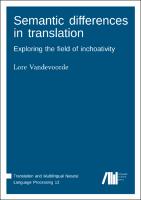Semantic differences in translation
Exploring the field of inchoativity
Author(s)
Vandevoorde, Lore
Collection
Knowledge Unlatched (KU)Number
105994Language
EnglishAbstract
Although the notion of meaning has always been at the core of translation, the invariance of meaning has, partly due to practical constraints, rarely been challenged in Corpus-based Translation Studies. In answer to this, the aim of this book is to question the invariance of meaning in translated texts: if translation scholars agree on the fact that translated language is different from non-translated language with respect to a number of grammatical and lexical aspects, would it be possible to identify differences between translated and non-translated language on the semantic level too? More specifically, this books tries to formulate an answer to the following three questions: (i) how can semantic differences in translated vs non-translated language be investigated in a corpus-based study?, (ii) are there any differences on the semantic level between translated and non-translated language? and (iii) if there are differences on the semantic level, can we ascribe them to any of the (universal) tendencies of translation? In this book, I establish a way to visually explore semantic similarity on the basis of representations of translated and non-translated semantic fields. A technique for the comparison of semantic fields of translated and non-translated language called SMM++ (based on Helge Dyvik’s Semantic Mirrors method) is developed, yielding statistics-based visualizations of semantic fields. The SMM++ is presented via the case of inchoativity in Dutch (beginnen [to begin]). By comparing the visualizations of the semantic fields on different levels (translated Dutch with French as a source language, with English as a source language and non-translated Dutch) I further explore whether the differences between translated and non-translated fields of inchoativity in Dutch can be linked to any of the well-known universals of translation. The main results of this study are explained on the basis of two cognitively inspired frameworks: Halverson’s Gravitational Pull Hypothesis and Paradis’ neurolinguistic theory of bilingualism.
Keywords
Language Arts & Disciplines; Linguistics; GeneralDOI
https://doi.org/10.5281/zenodo.2573677ISBN
9783961100736Publisher
Language Science PressPublisher website
https://langsci-press.org/Publication date and place
2020Grantor
Imprint
Language Science PressClassification
Linguistics


 Download
Download